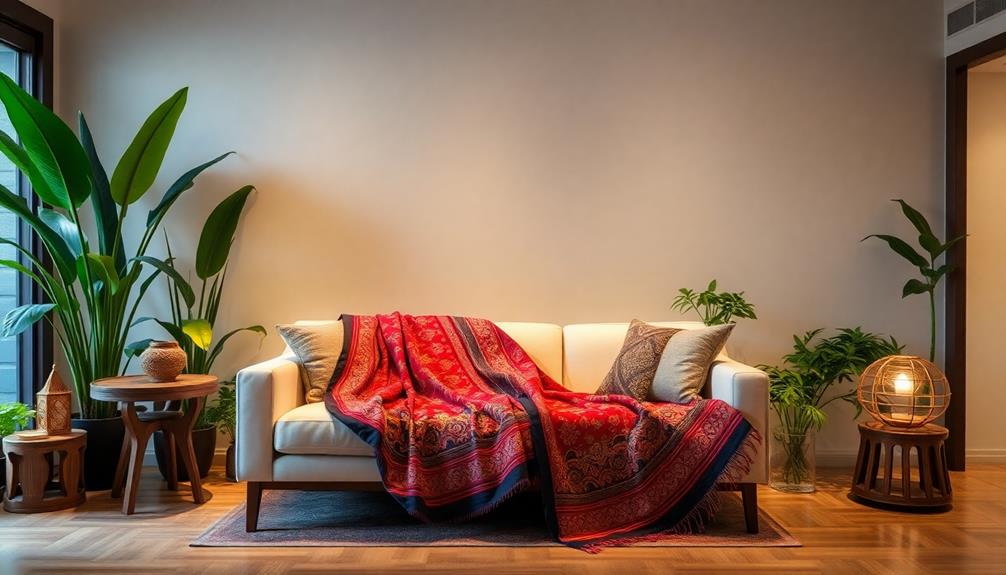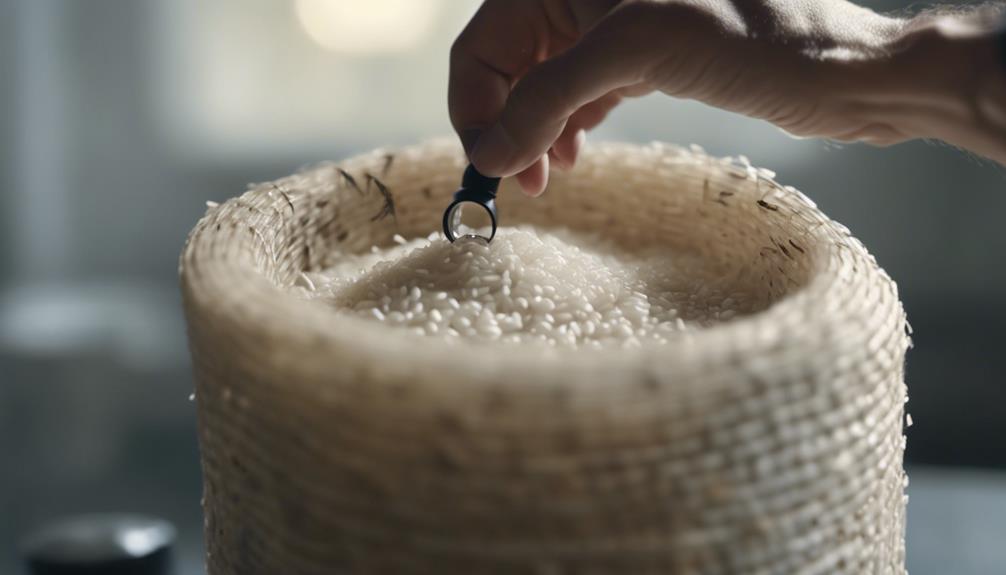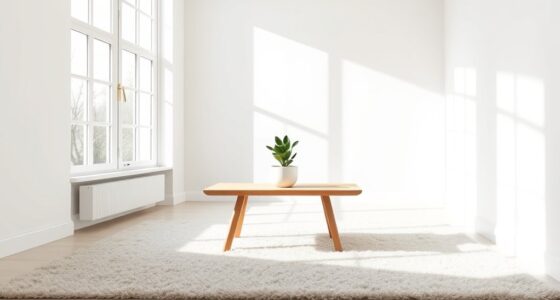Indonesian textiles, like batik and ikat, can instantly elevate your space into a designer masterpiece. Their vibrant colors and intricate patterns add warmth and character, transforming walls, couches, and dining tables. You can use batik for stunning wall art or drape ikat table runners for a chic dining experience. Throw in some batik cushions to enhance comfort and visual appeal. Each piece brings not just beauty, but also a rich cultural story and craftsmanship into your home. There's so much more to discover about how these textiles can redefine your decor.
Key Takeaways
- Vibrant batik patterns add color and cultural depth, transforming ordinary spaces into visually striking environments.
- Unique ikat textiles create a sense of history and tradition, enhancing the aesthetic appeal of any room.
- Incorporating batik cushions and lampshades introduces functional beauty, blending comfort with artistic expression in home decor.
- Curated table displays using batik elements foster engaging dining experiences, making each meal a celebration of Indonesian artistry.
- Sustainable textile practices contribute to eco-friendly interiors, promoting a connection to nature and cultural heritage in design choices.
The Allure of Batik
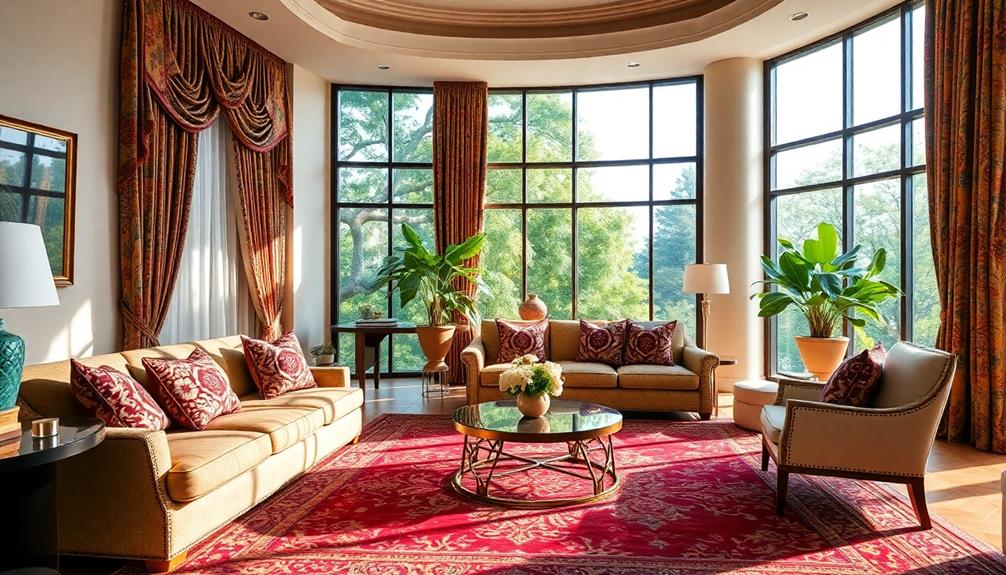
Batik, a UNESCO-recognized traditional Indonesian textile, captivates with its intricate designs and cultural depth. As you explore ways to elevate your home decor, consider the unique charm that batik brings. This textile employs a wax-resist dyeing technique that creates detailed patterns, making it a standout choice for various elements in your space.
Each motif carries significant meaning, like the Kawung, which symbolizes human life, or the Mega Mendung, promoting a sense of calmness. Additionally, incorporating batik not only enriches your decor but also supports local artisans and encourages appreciation for traditional craftsmanship.
You can incorporate batik into your interior design in numerous ways. Use it in curtains, throw pillows, or as stunning wall art to create a vibrant atmosphere that reflects your personal style. Modern adaptations make it easy to integrate batik into contemporary settings—think table settings or accent pieces that maintain the traditional artistry while adding a stylish touch.
Batik's versatility allows it to shift seamlessly from fashion to home accessories. As you choose batik for your decor, you're not just adding beauty; you're embracing a rich cultural heritage that enhances your living space, creating a designer masterpiece that tells a story.
Transforming Spaces With Wall Art
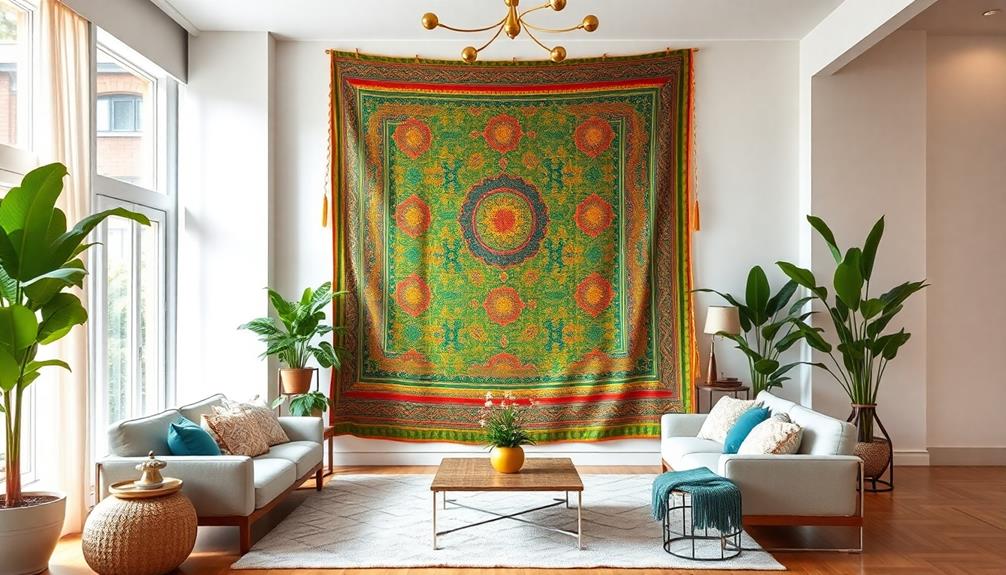
You can transform your walls with unique batik fabric displays that not only catch the eye but also tell a story.
Incorporating traditional artistry through vibrant Indonesian decor masks can further enhance the visual appeal of your space.
By using framing techniques that highlight the intricate patterns, you'll create a stunning focal point in any room.
This approach adds cultural depth while showcasing your personal style, making it a perfect conversation starter.
Unique Batik Fabric Displays
In recent years, unique batik fabric displays have emerged as an enchanting way to transform interior spaces into vibrant showcases of culture and artistry. By framing small pieces of batik fabric, you can create a stunning gallery wall that highlights the intricate designs and cultural significance of each textile.
These displays can be complemented by the importance of Indonesian decor masks, adding another layer of cultural storytelling to your decor. Combining different batik motifs and colors not only enhances visual interest but also infuses your room with a dynamic atmosphere.
Using batik fabric as wall hangings or tapestries serves as a focal point, adding texture and depth while reflecting Indonesian heritage. You can easily customize your displays by mounting batik on canvases or wooden boards, allowing you to align with your personal color schemes and themes.
Each piece tells a story, showcasing traditional techniques that celebrate the craftsmanship behind these textiles. Incorporating batik motifs into your wall art doesn't just beautify your space; it fosters appreciation for the rich storytelling embedded in each design.
Whether you opt for a single piece or a curated collection, unique batik fabric displays can truly elevate your home, making it an enthralling blend of style and culture.
Framing Techniques for Impact
Transforming spaces with wall art can be a game-changer for your home's aesthetic, and framing batik fabric pieces is an impactful way to achieve this. Incorporating Indonesian decorative pillows alongside your wall art can enhance the overall visual narrative of the room.
By showcasing intricate batik patterns, you can create stunning focal points that draw the eye and elevate your decor.
Here are three effective framing techniques to contemplate:
- Canvas Mounting: Stretch your batik fabric over a canvas for a sleek, modern look that enhances visual impact.
- Wooden Boards: Mount your batik on wooden boards for a rustic feel, adding warmth to your space while ensuring durability.
- Gallery Wall: Mix and match different batik patterns in a gallery wall setup to celebrate the rich cultural heritage of Indonesian textiles, adding depth and vibrancy.
Pay careful attention to your frame color and style; they should complement the batik patterns, creating a harmonious blend with your room's theme.
Customizing the arrangement based on color schemes can transform a bland wall into an eye-catching masterpiece, making it a true reflection of your personal style.
Framing batik art not only beautifies your home but also tells a story of culture and craftsmanship.
Elevating Dining Experiences
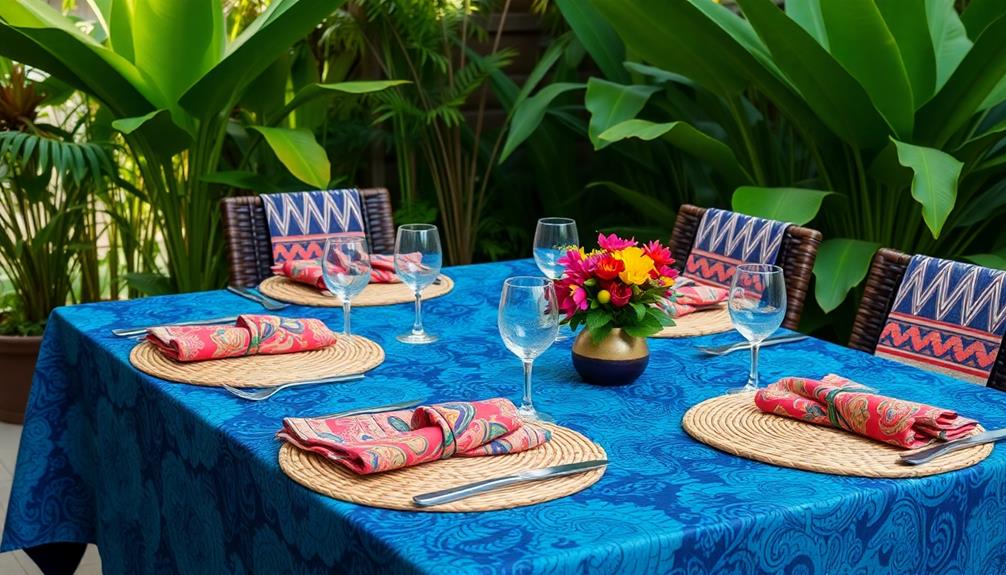
You can instantly transform your dining experience by incorporating batik table runners, which bring a vibrant touch to your table.
Mixing different batik designs not only creates an engaging display but also showcases the rich culture behind these textiles.
Batik Table Runners
Batik table runners bring together vibrant colors and intricate designs to elevate your dining experience, making any meal feel special.
These traditional Indonesian textiles add a touch of elegance while showcasing the rich heritage you want to share with your guests. Incorporating batik into your dining decor not only enhances aesthetics but also reflects the essence of traditional Indonesian style home decor.
Here's why you should consider incorporating batik runners into your dining decor:
- Cultural Connection: Each piece reflects the meticulous batik process, celebrating the artistry of Indonesian craftsmanship.
- Versatile Aesthetics: You can mix and match different patterns, creating a lively ambiance that suits any occasion—from casual family dinners to formal gatherings.
- Conversation Starter: The unique designs often spark discussions, allowing you to share stories about Indonesia's textile traditions with your guests.
Using batik table runners not only enhances the beauty of your dining table but also connects the past with contemporary design trends.
They're practical yet stylish, effortlessly transforming your dining setup into a designer masterpiece.
Vibrant Table Displays
A well-curated table display can effortlessly elevate any dining experience, creating an inviting atmosphere that captivates guests. By incorporating batik table runners, you introduce vibrant colors and intricate patterns that serve as a stunning backdrop for any meal. These traditional textiles not only add elegance but also a rich cultural significance that your guests will appreciate.
The use of vibrant colors like red, gold, and green from Indonesian wedding decor can further enhance the festive ambiance during special gatherings.
Using batik napkins and placemats enhances the table aesthetics, seamlessly blending traditional artistry with modern dining experiences. Don't be afraid to mix and match different batik designs; this creates a dynamic visual display that works for both casual gatherings and formal events alike.
Adding batik coasters to your table setting offers functional beauty, protecting surfaces while complementing your overall decor theme. The versatility of batik textiles allows them to shift seamlessly from everyday use to special occasions, making them ideal for enhancing your dining experience throughout the year.
With the help of modern Indonesian designers, you can curate a vibrant table display that's not just beautiful but also celebrates the rich heritage of Indonesian textiles. Your dining space will certainly become a conversation starter, delighting everyone at the table.
Elegant Dining Aesthetics
When you embrace elegant dining aesthetics, the atmosphere of your meals transforms, making each gathering feel special and intentional. Incorporating batik table runners adds a beautiful cultural charm to your table, whether you're hosting a casual brunch or a formal dinner.
The rich patterns and colors of batik textiles instantly elevate the aesthetic of your dining experience, much like the natural materials and earthy tones prevalent in Balinese decor.
To create a truly memorable setting, consider these three elements:
- Batik Napkins: These vibrant accents enhance the overall aesthetic, making each meal feel thoughtfully curated.
- Mix and Match Designs: Combining different batik patterns creates a dynamic and personalized display, showcasing your unique style and creativity.
- Batik Coasters: They not only protect surfaces but also tie together the visual elements of your table, ensuring a cohesive look.
Adding Comfort With Pillows
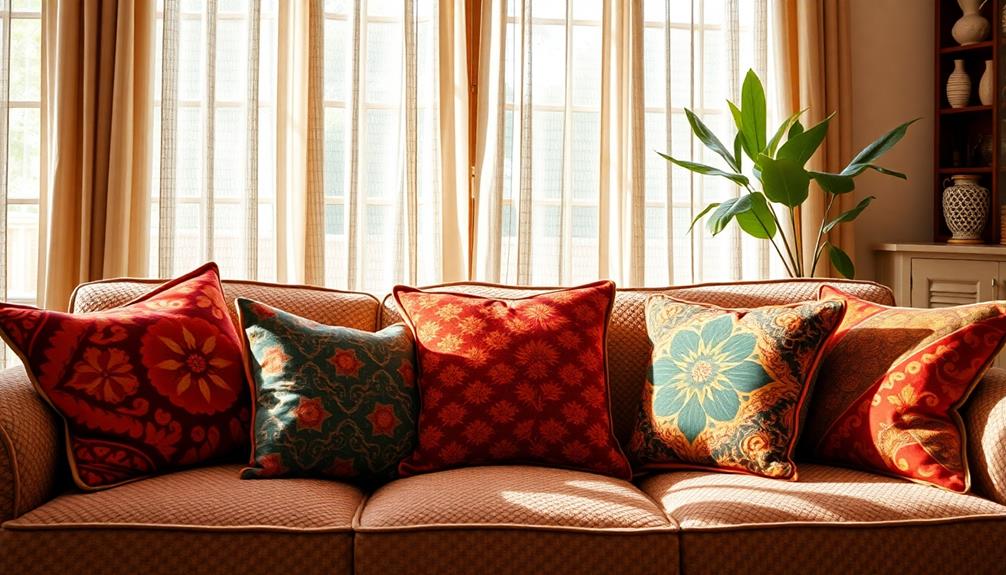
Throw pillows are an easy way to elevate comfort and style in your home, and incorporating Indonesian batik fabric can make a striking difference. Batik cushions bring vibrant colors and intricate designs that celebrate Indonesia's rich textile heritage, instantly adding cultural flair to your space.
Additionally, tropical design aesthetics can be beautifully complemented with these unique textiles, enhancing the overall ambiance of your living area.
To create a dynamic look, mix different shapes and sizes of batik pillows. This arrangement not only enhances the visual interest but also invites a cozy atmosphere. Pairing batik-patterned cushions with solid color ones can provide contrast and balance, making the unique batik designs pop even more.
One of the best features of batik cushions is their versatility. You can easily swap them out for seasonal decor updates, allowing you to refresh your home without a complete overhaul. This flexibility lets you maintain a stylish environment all year round.
Moreover, by choosing high-quality batik fabrics, you're not just elevating your home decor; you're also supporting local artisans and sustainable textile practices.
Unique Home Accessories
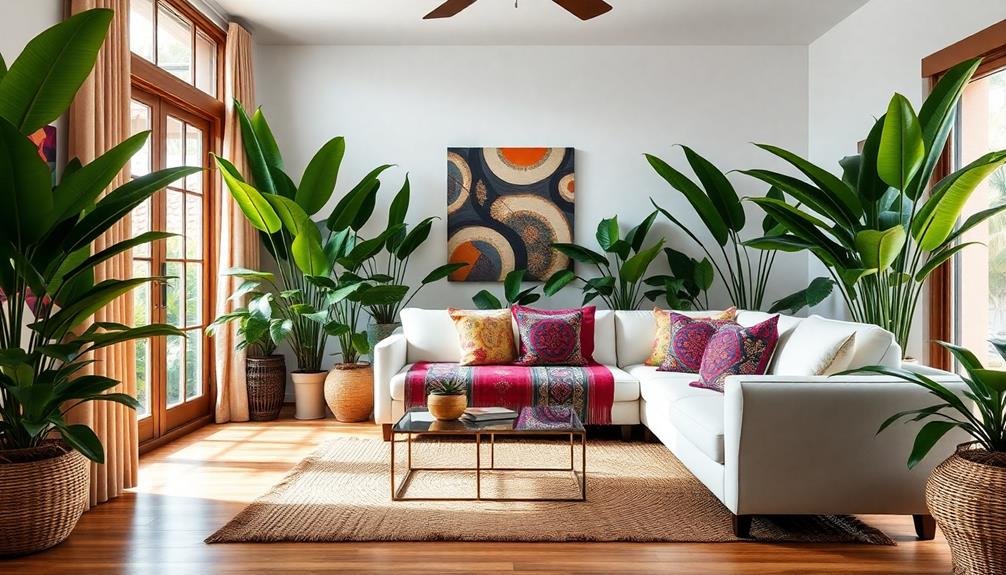
Home accessories can dramatically enhance your living space, and incorporating unique Indonesian textiles adds a distinct touch.
These textiles aren't just beautiful; they represent the Intangible Heritage of Humanity, showcasing rich cultural narratives through their intricate designs. Additionally, their use reflects the cultural significance of housing in Indonesia, where such textiles often signify social status and regional identity cultural symbolism in architecture.
Here are three unique accessories that can transform your home:
- Batik Lampshades: These lampshades create a warm ambiance while displaying stunning patterns. They illuminate your space with a cultural flair that's simply enchanting.
- Ikat Decorative Throw Pillows: Brighten your couch with these vibrant pillows. They not only provide comfort but also introduce a splash of color and artistry, making your living area inviting.
- Batik-Covered Storage Boxes: These boxes are perfect for organizing your items while serving as eye-catching decor. They reflect the craftsmanship of Indonesian artisans, adding a touch of tradition to any room.
The Rich Heritage of Ikat
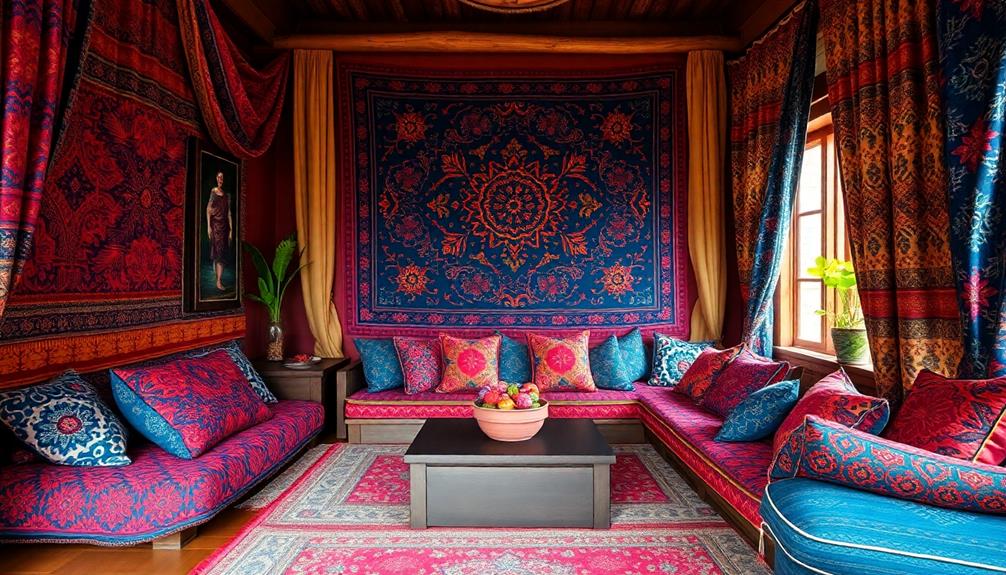
Ikat's rich heritage is woven into the very fabric of Indonesian culture, showcasing a mesmerizing dyeing technique that has been perfected over centuries. This traditional textile art form involves dyeing yarns before weaving, creating intricate patterns that reflect the cultural significance and heritage of various communities.
Originating centuries ago, ikat is closely tied to specific regions, symbolizing family lineage and local traditions. Additionally, ikat textiles can be beautifully incorporated into Indonesian wedding decor ideas, adding elegance and cultural depth to the celebration.
The skill of ikat weaving is often passed down through generations, primarily from mother to daughter, preserving this Oral and Intangible Heritage. Each design you see carries meanings linked to local customs, often used in ceremonial attire and daily life. This highlights weaving's central role in Indonesian culture, where every thread tells a story.
As global demand for ikat textiles grows, it positively impacts local economies and enhances appreciation for this diverse art form. By incorporating ikat into your home decor, you're not just adding beauty; you're celebrating a rich cultural legacy.
You'll connect your space to a tradition that embodies creativity, history, and community, making your design choices not just stylish but also meaningful.
Weaving Techniques and Craftsmanship
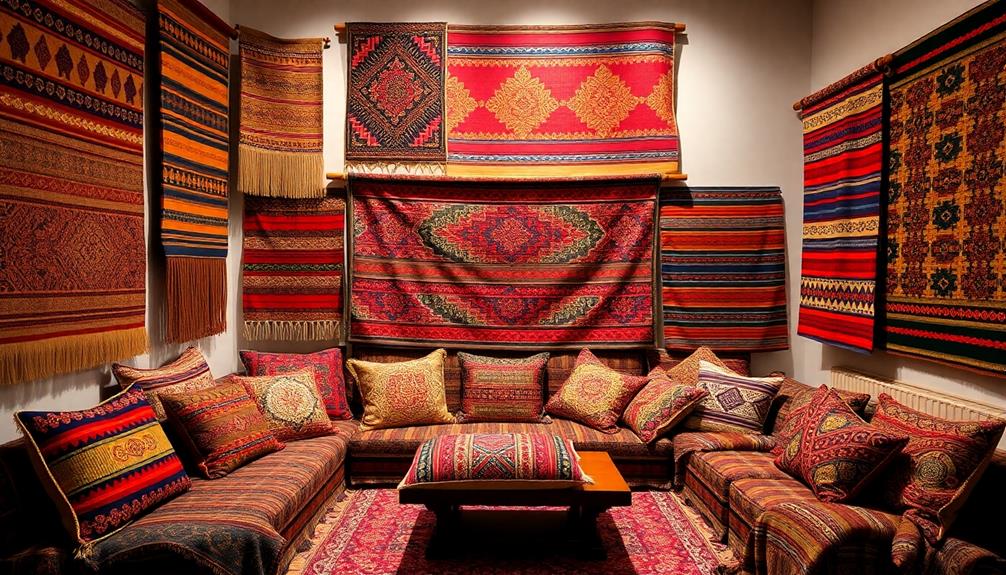
Embracing the intricate artistry of Indonesian textiles reveals a world of weaving techniques that reflect both skill and cultural significance. The craftsmanship behind these textiles isn't just about aesthetics; it embodies generations of tradition and meaning.
For instance, the ikat technique employs a resist-dyeing method, allowing artisans to create patterns that often signify familial and regional ties.
Here are three key aspects of Indonesian weaving techniques that make them stand out:
- Generational Knowledge: Artisans in Bali and Java pass down their skills through generations, ensuring that these techniques remain alive and relevant.
- Natural Dyes: The use of sustainable, natural dyes not only enhances the vibrancy of the fabrics but also showcases artisans' commitment to eco-friendly practices.
- Cultural Connection: Textiles like gerinsing from Tenganan Village serve ceremonial purposes, illustrating how craftsmanship is intertwined with cultural practices.
Modern Trends in Interior Design
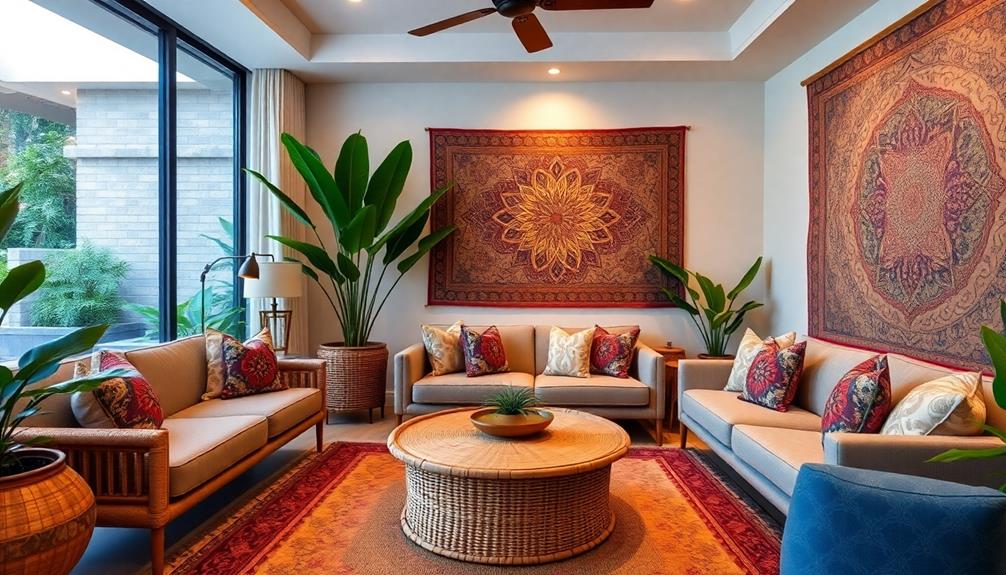
In today's interior design landscape, incorporating vibrant Indonesian textiles adds a unique character and warmth to your spaces. These high-quality textiles, like batik and ikat, not only enhance your home's visual appeal but also invite a sense of cultural richness.
You can create a harmonious blend of tradition and modernity by using these textiles in furniture upholstery, drapery, and accent pieces such as cushions. Mixing and matching different textile patterns allows you to personalize your decor, making your space truly one-of-a-kind.
Designers are increasingly opting for neutral palettes to serve as a backdrop, letting the intricate designs of Indonesian textiles shine. This approach highlights their cultural significance while drawing attention to their unique textures and colors.
The growing interest in sustainable fashion also plays a role in these modern trends. By choosing high-quality Indonesian textiles, you're not just decorating your home; you're supporting local artisans and preserving cultural heritage.
This trend encourages a thoughtful investment in pieces that elevate your decor while contributing positively to the community. Embrace these trends to transform your home into a designer masterpiece that reflects both style and substance.
Sustainable Practices in Textile Use
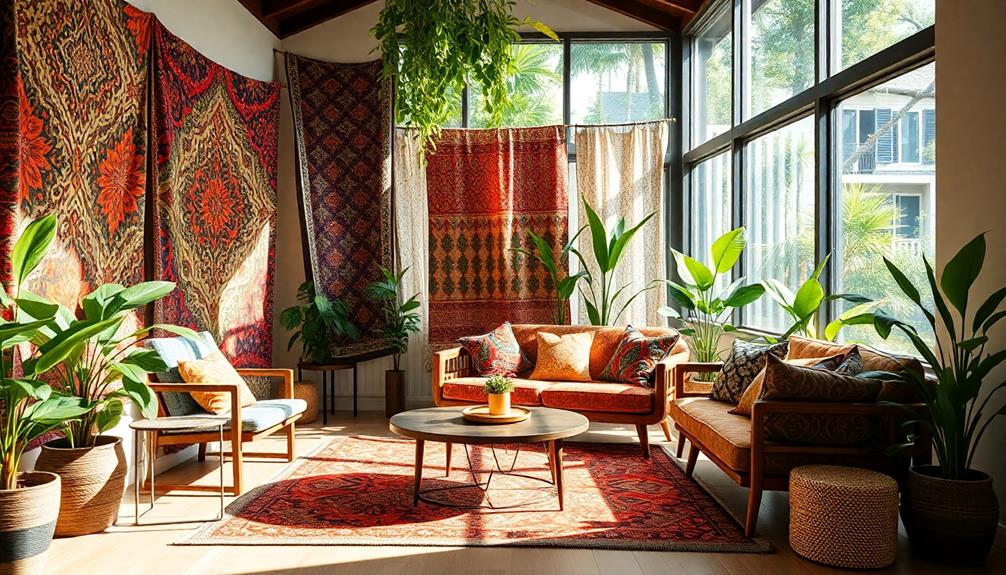
Sustainable practices in textile use are essential for preserving both the environment and cultural heritage. By choosing Indonesian textiles, you're not just enhancing your home; you're also supporting a movement that values craftsmanship and sustainability.
Here are three impactful reasons to embrace these practices:
- Natural Dyes: Many artisans use plant and mineral-based dyes, which greatly reduce environmental impact compared to synthetic alternatives. Your choices can help lessen pollution.
- Traditional Techniques: The slow fashion movement celebrates quality over quantity. By opting for handcrafted items, you're promoting longevity and supporting artisans who pour their heart into their work.
- Fair Trade: The rise in global demand for authentic textiles, like batik and ikat, has led to fair-trade practices, ensuring artisans receive fair compensation for their skills.
Celebrating initiatives like National Batik Day not only fosters appreciation for traditional techniques but also highlights the importance of sustainable production methods.
By integrating sustainable practices in textile use, you contribute to environmental conservation while uplifting local economies.
Frequently Asked Questions
What Is the Indonesian Textile Technique?
Indonesian textile techniques, like batik, involve intricate dyeing processes using wax-resist methods. You'll discover unique patterns and vibrant colors that reflect cultural heritage, making these textiles a stunning addition to your collection or décor.
What Is the Form of Textile Design From Indonesia?
Indonesian textile design includes various forms like batik, ikat, and lurik. Each technique showcases unique patterns and cultural significance, reflecting rich traditions. You'll appreciate the artistry and heritage behind every piece you encounter.
What Is Very Unique Process of Dyeing Fabric in Indonesia?
You'll be fascinated by Indonesia's intricate dyeing process. Imagine artisans applying hot beeswax to fabric, creating beautiful patterns. Then, they dye it multiple times, revealing vibrant colors and cultural stories woven into each unique piece.
What Is the Indonesian Method of Painting on Cloth?
The Indonesian method of painting on cloth, known as batik lukis, lets you create free-form designs. You use hot wax and dye to craft intricate patterns, resulting in vibrant, detailed artwork that expresses your unique style.
Conclusion
Incorporating Indonesian textiles into your home isn't just about aesthetics; it's a journey into rich cultural heritage. Did you know that batik craftsmanship has been recognized by UNESCO as an Intangible Cultural Heritage of Humanity? By embracing these unique fabrics, you not only elevate your space but also support sustainable practices and local artisans. So go ahead, transform your surroundings and create a designer masterpiece that tells a story—your story—through the vibrant patterns and textures of Indonesia.

